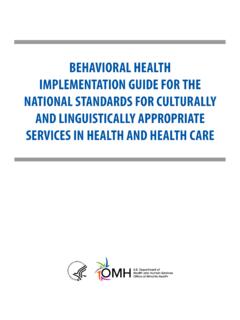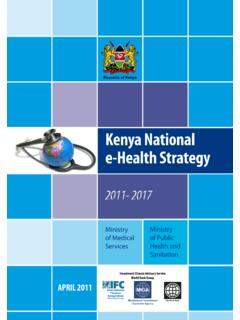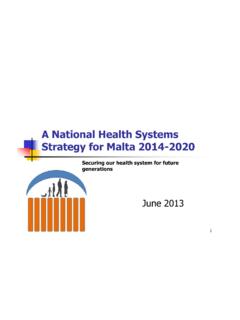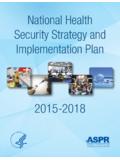Transcription of The National Stakeholder Strategy - Office of Minority Health
1 105 SECTION THREE National Stakeholder Strategy for Achieving Health Equity The National Stakeholder Strategy A PRACTICAL CONTEXT FOR CHANGE The fundamental purpose of the National Stakeholder Strategy is to promote systematic and systemic change that improves the overall Health of the nation.
2 Achieving this purpose will take time, include many people, and require that steps be taken incrementally while maintaining focus on the ultimate goal of achieving Health equity. In this regard, the information in this section addresses the practical matter of what may be required to influence change and improve outcomes for affected communities. It sets out a Strategy for change based on the five key goals and 20 strategies that were developed through the extended grass roots process that is described in Section 1 (see also Exhibit ). The goals and their corresponding strategies provide a starting point and menu of resources for stakeholders to design actions that are achievable through their scopes of influence and areas of expertise. It is important to reiterate the message from Section 1 that the National Stakeholder Strategy responds to the voices of thousands of leaders from across the United States who called for actions to effectively and efficiently address Health and healthcare disparities in this country.
3 These leaders represented community based organizations; faith based organizations; the business sector; healthcare workforce; Health and insurance industries; academia; local, state, tribal, and federal governments; and others. The National Stakeholder Strategy is also based on Congressional language, which called for a National Strategy that is implemented and monitored in partnership with state and local governments, communities, and the private sector. Partnerships within and beyond the Health sector can address crosscutting, multilevel issues to achieve Health equity. Formation of wide ranging partnerships is the next best step forward towards tackling this ultimate goal. It will be the job of change oriented organizations and individuals to take the goals and strategies in this document and adapt them to their own missions, interests, and needs in order to develop the actions that they can implement to effect change.
4 The resources in this section are not necessarily the final or only methods for ending Health disparities and achieving Health equity. That is, each Strategy is not necessarily applicable to all stakeholders. Rather, this National Stakeholder Strategy provides a common reference point, language, and initial set of actions for any group that wishes to seriously engage in ending Health disparities. This is especially important for the development of strong, strategic, collaborative partnerships among disparate organizations. The hope is that stakeholders will be encouraged to use the goals and strategies to ensure focused progress toward achieving Health equity. The overarching benchmark that all should aim to realize is the Completed actions - Strategies implemented through action stepsEffective leveraging of resources and relationsIncreased capacity reduction in the incidence and prevalence of Health conditions and diseases for which disparities exist, and to seek the gradual elimination of the determinants that are the root causes of poor Health .
5 106 SECTION THREE National Stakeholder Strategy for Achieving Health Equity With this practical background in mind, the following subsection briefly describes a theoretically based context for change. The theory of change model was developed to reflect the process that would begin at this juncture of the National Stakeholder Strategy s history. This model is a general road map to ensure that individuals, organizations, and partners stay focused while engaging in incremental steps that lead to the end of Health disparities. A THEORETICAL CONTEXT FOR CHANGE As shown on the following diagram, the context for change model begins on the far left with input from partnerships ( , local, state, tribal, regional, and National ) that play the primary role in setting the initial context for change and the impetus for its continuation. The far right of the diagram displays the final output the overriding goal of the end of Health disparities through changing adverse determinants of Health and improving Health outcomes.
6 The input, output, and intervening steps all have arrows to indicate the interrelationships of all the steps and the iterative nature of the whole process. END Health DISPARITIES Impacted determinants of Health Leadership demand to end disparities Successful system, policy, and other multi-level changes Achieved goals Exhibit 3 1: Context for Change Improved Health outcomes Composition, structure, process, and function of partnerships Resources (funds, human capital, etc.) for capacity building and evaluation POLITICAL, ECONOMIC, SOCIAL, and CULTURAL CONDITIONS Public demand to end disparities 107 SECTION THREE National Stakeholder Strategy for Achieving Health Equity The composition, structure.
7 Process, and function of partnerships will affect their capacity and effectiveness. The partnerships and the entire process depend on resources to build their capacity to function effectively and efficiently and to initiate and evaluate their efforts. Resources include not only funding, but also the necessary resources of knowledge, skills, and other forms of support and human capital that lie within or outside the partnerships. The capacity of partners increases and becomes more effective as they leverage resources and the relationships required to prioritize their objectives and to develop and implement actions that support their strategies. An interactive and iterative effect between the partnerships initial and increased capacities points to a continuous process of improvement. Implementation of the strategies could lead to the partial or total achievement of one or more of the five goals and impact two key levers of change: leadership and public demand to end disparities.
8 The combined impact would be successful system, policy, and other multilevel changes. Over time, the continuous interaction among goal attainment, successful changes, leadership, and public demand to end disparities would affect the conditions in which people are born, grow, learn, live, work, play, and age ( , determinants of Health ) leading finally to an improvement in the Health outcomes of people who experience disparities. The model emphasizes an iterative cycle of adjustments to the partnerships structure, process, composition, and functions in order to If we as a country want to continuously increase their capacity, resources, and relationships for learn how to create an effective achieving their goals. Partnerships will operate within particular healthcare system for all, political, economic, social, and cultural contexts. These contexts can it s really important to hear the dramatically affect the change process.
9 The ability to work across cultures those based on racial, ethnic, and cultural identities and voices of all. those based on geographic and organizational settings affects NPA Regional Meeting participant every goal, Strategy , objective, and action. The remainder of this section lays out background information for each of the five NPA goals and links them to the 20 strategies that were developed through the grass roots process that produced this National Stakeholder Strategy for Achieving Health Equity.
10 108 SECTION THREE National Stakeholder Strategy for Achieving Health Equity Exhibit 3 2: SUMMARY OF NPA GOALS AND STRATEGIES Goal # Goal Description Strategies 1 AWARENESS Increase awareness of the significance of Health disparities, their impact on the nation, and the actions necessary to improve Health outcomes for racial, ethnic, and underserved populations 1. Healthcare Agenda Ensure that ending Health disparities is a priority on local, state, tribal, regional, and federal healthcare agendas 2. Partnerships Develop and support partnerships among public, nonprofit, and private entities to provide a comprehensive infrastructure to increase awareness, drive action, and ensure accountability in efforts to end Health disparities and achieve Health equity across the lifespan 3. Media Leverage local, regional, and National media outlets using traditional and new media approaches as well as information technology to reach a multi tier audience including racial and ethnic Minority communities, youth, young adults, older persons, persons with disabilities, LGBT groups, and geographically isolated individuals to encourage action and accountability 4.














